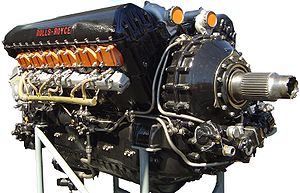Rolls Royce Merlin
| Merlin | |
|---|---|
 |
|
| The Rolls-Royce Merlin | |
| Type | Liquid-cooled V-12 piston aero engine |
| National origin | United Kingdom |
| Manufacturer | Rolls-Royce Limited |
| First run | 15 October 1933 |
| Major applications |
Avro Lancaster de Havilland Mosquito Handley Page Halifax Hawker Hurricane Supermarine Spitfire |
| Number built | 149,659 |
| Unit cost |
£2,000 (Engine) £350 (Propeller) |
| Variants | Packard V-1650 Merlin |
| Developed into | Rolls-Royce Meteor |
The Rolls-Royce Merlin is a British liquid-cooled V-12 piston aero engine of 27-litres (1,650 cu in) capacity. Rolls-Royce designed the engine and first ran it in 1933 as a private venture. Initially known as the PV-12, it was later called Merlin following the company convention of naming its piston aero engines after birds of prey.
After several modifications, the first production variants of the PV-12 were completed in 1936. The first operational aircraft to enter service using the Merlin were the Fairey Battle, Hawker Hurricane and Supermarine Spitfire. The Merlin remains most closely associated with the Spitfire and Hurricane, although the majority of the production run was for the four-engined Avro Lancaster heavy bomber. A series of rapidly applied developments, brought about by wartime needs, markedly improved the engine's performance and durability. Starting at 1,000 hp for the first production models, most late war versions produced just under 1,800 hp, and the very latest version as used in the de Havilland Hornet over 2,000 hp. Lancasters were known to fly entire missions with their engines running at full power with no ill effects.
One of the most successful aircraft engines of the World War II era, some fifty marks of Merlin were built by Rolls-Royce in Derby, Crewe and Glasgow, as well as by Ford of Britain at their Trafford Park factory, near Manchester. A de-rated version was also the basis of the very successful Rolls-Royce/Rover Meteor tank engine. Post-war, the Merlin was largely superseded by the Rolls-Royce Griffon for military use, with most Merlin variants being designed and built for airliners and military transport aircraft. Production ceased in 1956 with the fulfilment of an order for 170 Merlins for the Spanish Air Force's CASA 2.111 and Hispano Aviación HA-1112 aircraft, after 160,000 engines had been delivered. In addition, the Packard V-1650 was a version of the Merlin built in the United States, itself produced in numbers upwards of 55,000 examples, and was the principal engine used in the North American P-51 Mustang.
...
Wikipedia
